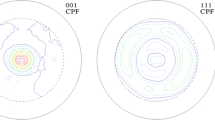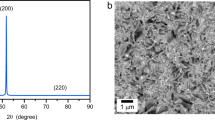Abstract
The microscale and mesoscale crystallographic textures observed in nanocrystalline Ni, Ni-20 pct Fe, and Ni-50 pct Fe electrodeposits are described. The nanosized grains are arranged in coarse mesoscale colonies. In the as-deposited state, the bulk texture of the Ni-20 pct Fe alloy displays a dominant 〈001〉 fiber parallel to the macroscopic deposition direction (DD). The grains are elongated along the 〈001〉 crystal lattice direction, which is mostly parallel to the local DD, producing a well-defined 〈001〉//DD fiber microtexture on a local scale. The grain misorientation histograms show some content of low-angle boundaries, frequently associated with the presence of grain clusters, and are dominated by high-angle boundaries with a possible enhanced frequency of ∑5 and ∑7 coincident site lattice boundaries and a significant content of ∑3 twin boundaries. For all three alloys, the coarsened grains, obtained by annealing, within the mesoscale colonies show a fiber mesotexture characterized by a 〈111〉 axis approximately perpendicular to the colony hemispherical growth surface (parallel to the local DD). It is surmised that a similar “cobblestone” mesotexture with a 〈001〉 fiber axis already exists in the as-received state, as previously proposed by a number of the present authors and as supported by the results on the Ni-20 pct Fe alloy presented here.













Similar content being viewed by others
Notes
PHILIPS is a trademark of FEI Company, Hillsboro, OR.
References
M. Dao, L. Lu, R.J. Asaro, J.T.M. De Hosson, and E. Ma: Acta Mater., 2007, vol. 55, pp. 4041–65.
U. Erb: Nanostruct. Mater., 1995, vol. 6, pp. 533–38.
B.Y.C. Wu, P.J. Ferreira, and C.A. Schuh: Metall. Mater. Trans. A, 2005, vol. 36A, pp. 1927–36.
S. Ruan and C.A. Schuh: Scripta Mater., 2008, vol. 59, pp. 1218–21.
C. Kollia and N. Spyrellis: Surf. Coat. Technol., 1993, vol. 58, pp. 101–05.
H.S. Karayannis and G. Patermarakis: Electrochim. Acta, 1995, vol. 40, pp. 1079–92.
F. Czerwinski, H. Li, M. Megret, and J.A. Szpunar: Scripta Mater., 1997, vol. 37, pp. 1967–72.
F. Czerwinski and J.A. Szpunar: Nanostruct. Mater., 1999, vol. 11, pp. 669–76.
M.R. Barnett, P. Cizek, M. Nave, A. Sullivan, and R. Balasubramaniam: Scripta Mater., 2009, vol. 60, pp. 603–06.
E.F. Rauch and L. Dupuy: Arch. Metall. Mater., 2005, vol. 50, pp. 87–99.
E.F. Rauch and M. Veron: J. Mater. Sci. Eng. Technol., 2005, vol. 36, pp. 552–56.
C.T. Forwood and L.M. Clarebrough: Electron Microscopy of Interfaces in Metals and Alloys, IOP Publishing, New York, NY, 1991, pp. 84–90.
A. Morawiec and E. Bouzy: J. Appl. Cryst., 2006, vol. 39, pp. 101–03.
E.F. Rauch and L. Dupuy: J. Appl. Cryst., 2006, vol. 39, pp. 104–05.
B. Hutchinson: personal communication, Deakin University, Australia, 2010.
U. Klement, U. Erb, A.M. El-Sherik, and K.T. Aust: Mater. Sci. Eng., 1995, vol. A203, pp. 177–86.
U. Klement and M. da Silva: J. Alloys Compd., 2007, vols. 434–435, pp. 714–17.
H. Li, F. Czerwinski, and J.A. Szpunar: Nanostruct. Mater., 1997, vol. 9, pp. 673–76.
F.J. Humphreys and M. Hatherly: Recrystallization and Related Annealing Phenomena, 2nd ed., Elsevier, Oxford, United Kingdom, 2004.
J.H. Seo, J.K. Kim, and Y.B. Park: in Processing and Properties of Structural Nanomaterials, L.L. Shaw, C. Suryanarayana, and R.S. Mishra, eds., TMS, Warrendale, PA, 2003, pp. 213–18.
W.F. Hosford: The Mechanics of Crystals and Textured Polycrystals, The Oxford Engineering Science Series, Oxford University Press, New York, NY, 1993.
Author information
Authors and Affiliations
Corresponding author
Additional information
Manuscript submitted March 16, 2010.
Appendix
Appendix
1.1 Selection of Upper or Lower Hemisphere for Plotting Pole Figures
The EBSD maps presented in this article were collected on cross sections taken perpendicular to the DD. It was not known whether the DD was pointing toward (Figure A1) or away from (Figure A2) the EBSD detector. If the DD was toward the EBSD detector (Figure A1(a)), upper-hemisphere 〈111〉 pole figures taken from regions A through C would appear, as shown in Figure A1(b), while lower-hemisphere pole figures would appear, as shown in Figure A1(c). If the DD was away from the EBSD detector (Figure A2(a)), upper-hemisphere 〈111〉 pole figures taken on regions A through C would appear, as shown in Figure A2(b), while lower-hemisphere pole figures would appear, as shown in Figure A2(c).
Note that the pole figures in Figures A1(b) and A2(c) are the same, while those in Figures A1(c) and A2(b) are the same. Consequently, if data collected on a specimen with the DD pointing away from the EBSD detector are plotted using the lower hemisphere, the pole figure has the same appearance as the data collected on a specimen with the DD pointing toward the EBSD detector and plotted using the upper hemisphere. In this article, some of the pole figures have been plotted using the upper hemisphere and some have been plotted using the lower hemisphere, so that all of the data appear as if they have been collected from a specimen with its DD pointing toward the EBSD detector. This enables the pole figures from different specimens to be compared quickly and easily.
Implicit in this approach is the assumption that the tilt in the dominant local 〈111〉 direction near the colony boundary is such that it stays approximately perpendicular to the colony hemispherical growth surface, rather than tilting in the opposite direction. This assumption is justified on the basis that this direction of tilt was seen in EBSD measurements made on the transverse section of a Ni-20 pct Fe specimen, where the DD was indicated by the curvature of the colony boundaries and segregation layers (Figure 3 in Reference 9).
Rights and permissions
About this article
Cite this article
Cizek, P., Barnett, M.R., Nave, M.D. et al. Microscale and Mesoscale Crystallographic Textures of Nanocrystalline Ni-Based Electrodeposits. Metall Mater Trans A 42, 2048–2060 (2011). https://doi.org/10.1007/s11661-010-0583-x
Published:
Issue Date:
DOI: https://doi.org/10.1007/s11661-010-0583-x






